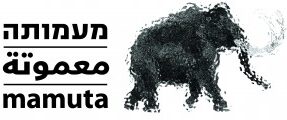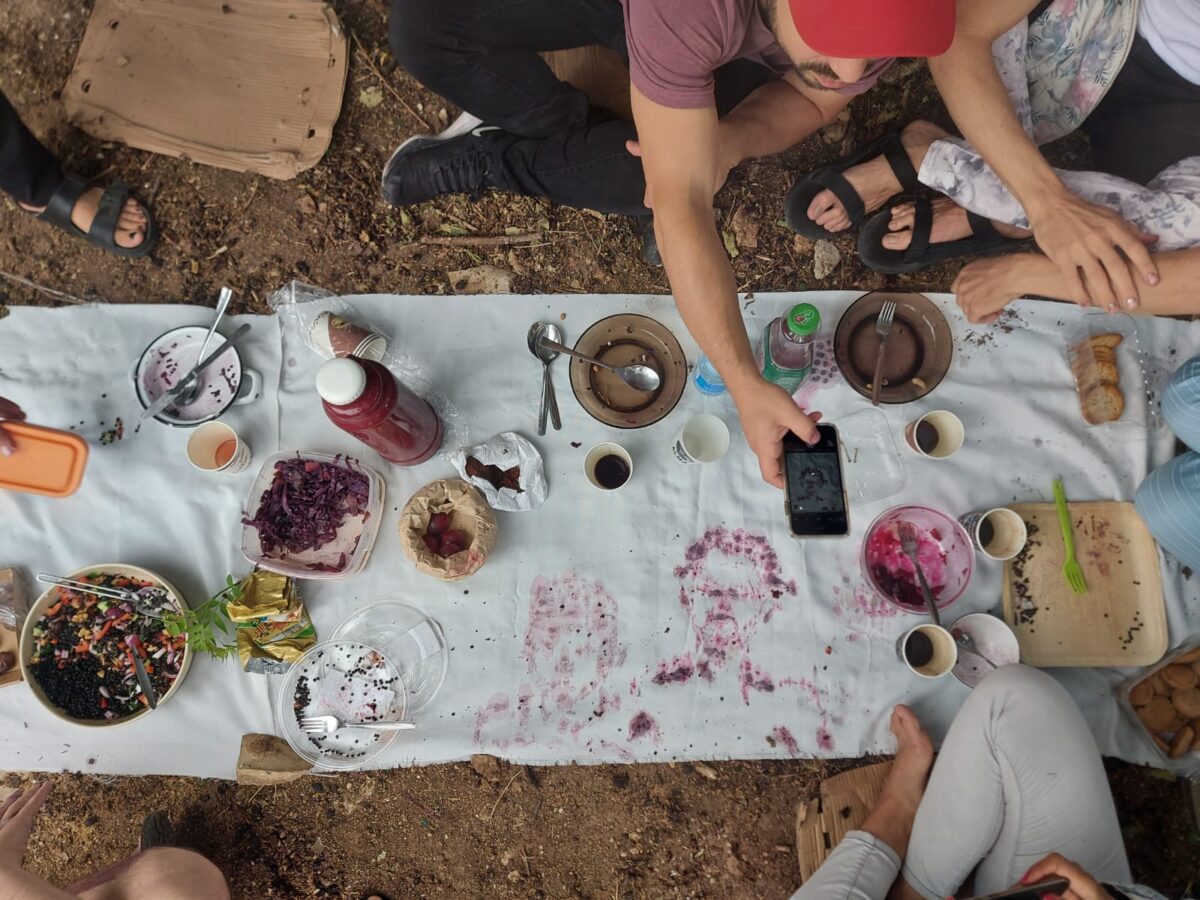Hadas Duchan, Agustín Jais, Ruth Hof, Dafna Talmon, Dan Robert Lahiani, Avner Pinchover, Holeket - Uri Karin
Curator: Irit Carmon – Popper
15.10.21 - 15.12.21
We began meeting at the end of the lockdowns (February 2021). With the world slowly opening up around us, we resumed our bi-weekly meetings at Mamuta’s residency program in order to investigate a common theme: “the performativity of space.” A buzz of excitement filled the air: to move, to mingle, to stride distances at varying speeds in order to convene in dialogue and action. The meetings took the form of a group studio, in which we shared work processes and practices having to do with performance, public space, activism, and ethics, and we examined the reciprocal relations between independent movement, collective movement, and space.
At our collective breakfasts, held in public spaces throughout the city, we tried to digest what we had been through and what lay before us — the possibility of work/action on the one hand, and the open space on the other. Around the rectangular outline of the breakfast table we created a fabric for sharing ideas and inspirations, and this gave us air to breathe. We burst open the closed perimeter by drawing independent lines outward from it to different points in the city, in the form of tours led by the group members. The tours expressed personal, day-to-day, urban experiences, physical and mental pathways that challenged the familiar urban ways and trails.
The exhibition features installations, video, sound, and performance works that were created in the wake of the tours — an attempt to bring the outside inside, to give it a physical representation or expression in the gallery space. From this attempt/experience tThe gallery space hosts fragments — material, formal, and auditory — that resonate the experience of wandering and rambling. The works testify to the different interpretations of the fluid concept of space and publicness, through an examination of the borders between movement and stillness, self-expression and collective belonging, between the individual, the group, and the institution. The heterogeneity of the group manifests itself in the wide array of materials, content, and images in the exhibition. The multiplicity of gazes and musings about wandering reveals layers that are generally hidden from view by the familiar urban rationale and order. As such, the exhibition space functions as a kind of absurdist tourist space, offering different ways of looking at urban phenomena.
Dan Robert Lahiani’s video work documents a steep walk between two neighborhoods — the Talpiot industrial zone and Beit Safafa — directing our gaze at the geographical gap between them as an expression of blatant social and spatial injustice. Avner Pinchover’s video work, based on an independent tour with “The Mobile Public Welding Unit,” follows the welding signs that Pinchover left in his wake. Their non-disclosure raises issues of civic responsibility, aesthetics, and functionality, as well as ethical musings about the possibility of existence in the neglected urban space. Dafna Talmon’s video work takes the form of a diptych, juxtaposing fragments from a woman’s nighttime walk from Mea She’arim toward the Western Wall, ending with sunrise in a personal ceremony that leads to joy; with fragments from Talmon’s own daily personal ritual of swimming in the pool — arousing a discussion about the ways in which we search for and cling to happiness.
Hadas Duchan’s sculptural installation takes the listener on an audio walk, setting out from the gallery to the outside space and guiding the listener in an action of bringing an offering to the “temple.” The private wandering is rendered collaborative through the act of collecting offerings that become part of the sculpture, which is in a process of constant change. Ruth Hof’s audio work also offers a personal experience of rambling, though hers goes inward into personal memory and imagination. Her voice invites us to join the table installation in the gallery space and to try our hand at a reverse activity of writing letters to ourselves from a stranger.
Agustín Jais, in a site-specific installation based on sketches and pedagogical material, invites us to exchange information and inspiration between sites that symbolize political conflicts in Jerusalem to an activist artistic act in Chile and Argentina. Building upon this temporal back-and-forth he creates a performance lesson in the gallery as well as a walking tour that goes through Paris Square, the Muslim cemetery in Mamilla, and the Museum of Tolerance. In the sound installation “A-Nahnu” by Holeket ~ Uri Karin, the group sounds pluck on ancient strings inspired by the chorus from Greek tragedy: reflecting the thoughts of the characters, analyzing the dramatic situation, and expressing an opinion in order to help us take a stance. But the image is absent, and the voice of reason, which the original chorus is meant to reproduce, is replaced by the sound of emotion.
***
The concept of “equalizing matter” in the natural sciences refers to the movement of molecules from a state of high concentration to a low concentration, or from one side of a permeable membrane to the other, until reaching a state of equilibrium. We have borrowed the term in this exhibition to describe a gradual process of influence and learning within a group over an extended period of time, striving toward a state of equilibrium between individuals, materials, tools, and worldviews — as happened in the group studio of the residency at Mamuta.
Common Breakfast
Friday, 12.11, 10:30
As part of the residency program (after a long series of confinements), the group members shared work processes and practices regarding performance, publicity, activism and morality and examined the interrelationships between self-movement, collective movement and space. Through organized breakfasts which took place in public spaces in the city, the artists sought to explore what was and what lay before them – the possibility to act on the one hand and the open space on the other. Around the rectangular contour outlined by the dining table was created a sharing weave of ideas and inspiration, which provided breath.
Inspired by this process, we will organize a breakfast open to anyone who wants to join, chat and share their thoughts.
Around the rectangular outline of the breakfast table we created a fabric for sharing ideas and inspirations, and this gave us air to breathe. We burst open the closed perimeter by drawing independent lines outward from it to different points in the city, in the form of tours led by the group members. The tours expressed personal, day-to-day, urban experiences, physical and mental pathways that challenged the familiar urban ways and trails.
22.10 – Tracking / Dafna Talmon
A night tour as part of Dafna Talmon’s work. The tour will depart from Mea-Shearim neighborhood towards the Western Wall, and will end at sunrise with a personal ceremony leading to joy. Meeting Point: Shabbat Square at 4:40 a.m. Please bring clothing for cold weather.
5.11- «En danseuse» / Dan Robert Lahiani
We’ll walk between two neighborhoods, the Talpiot industrial zone and Beit Safafa, while shifting the gaze to the geographical gap between them as an expression of prominent spatial and social injustice. The tour will depart from Dan’s studio at the Artists’ Studio and will end at Beit Safafa. Meeting Point: 26 HaOman Street in the Talpiot neighborhood, at 11:00.
19.11 We/ are the tour / Holeket ~ Uri Karin
We/ will tour around Musrara, one of the most visited neighborhoods in Jerusalem. The tours in Musrara usually focus on a certain topic or a certain angle to look at the neighborhood. Not so in our case – we will meet whatever it is that will meet us. The main tool that the tour guides use is speech. However,
We/ this is an invitation to participate in the Us/W-e tour, to experience it and also (for a short period of time) to guide it.
Friday, 11.19, 11:00. The meeting point will be sent after the registration.
26.11- Introduction to Artistic Activism in South America / Agustin Jais
In a tailor-made installation based on drawing and pedagogical materials, Agustin invites us to exchange information and inspiration between sites that symbolize political conflicts in Jerusalem and activist art activities in Chile and Argentina. Walking back and forth in time and space is the basis for a performance class in the gallery.
Friday 26/11 11:00 at Mamuta Art and Research Center
3.12- Exchange Change / Agustin Jais
Following the work of Agustin who invites us to exchange information and inspiration between sites that symbolize political conflicts in Jerusalem and activist art activities in Chile and Argentina, we will go on a walking tour around Paris Square, the Muslim Cemetery in Mamilla and the Museum of Patience. Meeting Point: Paris Square at 11:00.
The show is possible thanks to the support of the Ministry of Culture, The Jerusalem Municipality and the Jerusalem Foundation.
Artist Appointment 2021
Wednesday, 27.10, 18:00
As part of the Manofim Jerusalem Contemporary Art Festival , one-on-one sessions with Jerusalem based artists will take place in various places around the city, including the artists of our current exhibition. This is a unique opportunity to get a behind-the-scenes glimpse, to get to know the hidden layers of the work and even take part in the artistic action itself.
participants: Hadas Duchan, Dafna Talmon, Avner Pinchover, Holeket ~ Uri Karin, Agustin Jais, Dan Robert Lahiani, Ruth Hof








Exhibition events:
There are no upcoming events at this time
No related events found.

